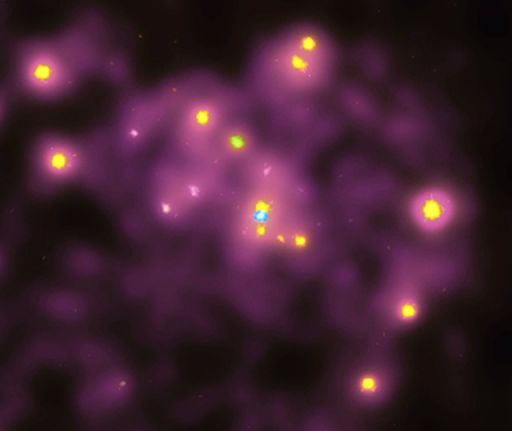 |
This is a file from the Wikimedia Commons. Information from its description page there is shown below.
Commons is a freely licensed media file repository. You can help.
|
Summary
| Description |
English: Using the newly unleashed observing power of the orbiting Chandra X-ray telescope, astronomers have now imaged the center of our near-twin island universe, finding evidence for an object so bizarre it would have impressed many 60s science fiction writers (and readers). Like the Milky Way, Andromeda's galactic center appears to harbor an X-ray source characteristic of a black hole of a million or more solar masses. Seen above, the false-color X-ray picture shows a number of X-ray sources, likely X-ray binary stars, within Andromeda's central region as yellowish dots. The blue source located right at the galaxy's centre is coincident with the position of the suspected massive black hole. While the X-rays are produced as material falls into the black hole and heats up, estimates from the X-ray data show Andromeda's central source to be surprisingly cool - only a million degrees or so compared to the tens of millions of degrees indicated for Andromeda's X-ray binaries.
|
| Date |
21 January 2000 |
| Source |
Astronomy Picture of the Day, url= http://apod.nasa.gov/apod/ap000121.html |
| Author |
S. Murray, M. Garcia, et al., Authors & editors: Robert Nemiroff (MTU) & Jerry Bonnell (USRA) NASA Technical Rep.: Jay Norris. |
Permission
( Reusing this file) |
Images produced by NASA are usually free of copyright [...]
|
A big beautiful spiral galaxy 2 million light-years away, Andromeda (M31) has long been touted as an analog to the Milky Way, a distant mirror of our own galaxy. The popular 1960s British sci-fi series, A For Andromeda, even postulated that it was home to another technological civilization that communicated with us.
Licensing
| Public domainPublic domainfalsefalse |
 |
This file is in the public domain because it was solely created by NASA. NASA copyright policy states that "NASA material is not protected by copyright unless noted". (See Template:PD-USGov, NASA copyright policy page or JPL Image Use Policy.) |
|
|
|
Warnings:
- Use of NASA logos, insignia and emblems are restricted per US law 14 CFR 1221.
- The NASA website hosts a large number of images from the Soviet/ Russian space agency, and other non-American space agencies. These are not necessarily in the public domain.
- Materials based on Hubble Space Telescope data may be copyrighted if they are not explicitly produced by the STScI. See also {{ PD-Hubble}} and {{ Cc-Hubble}}.
- The SOHO (ESA & NASA) joint project implies that all materials created by its probe are copyrighted and require permission for commercial non-educational use.
- Images featured on the Astronomy Picture of the Day (APOD) web site may be copyrighted.
|
File usage
The following pages on Schools Wikipedia link to this image (list may be incomplete):
Schools Wikipedia was launched to make learning available to everyone. SOS Children cares for children who have lost their parents. Our Children's Villages give these children a new home and a new family, while a high-quality education and the best of medical care ensures they will grow up with all they need to succeed in adult life. Have you thought about sponsoring a child?





